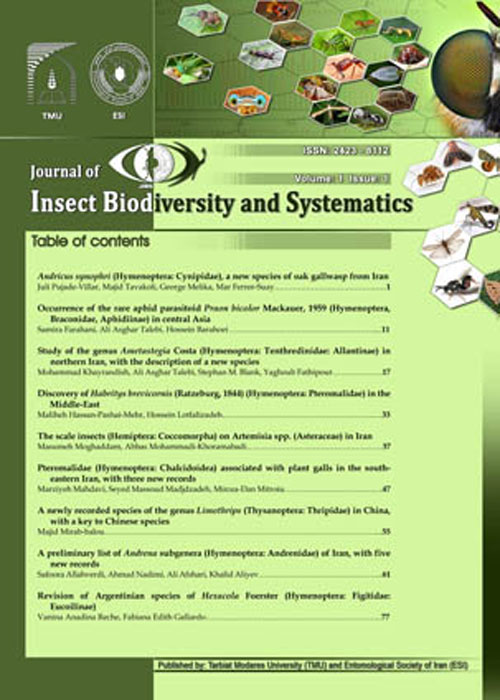فهرست مطالب

Journal of Insect Biodiversity and Systematics
Volume:2 Issue: 2, Jun 2016
- تاریخ انتشار: 1395/07/14
- تعداد عناوین: 7
-
-
Pages 181-192Eupelmidae of Iran are revised based on collected material mainly from the northwest and accessible published data. This family in Iran includes 31 species in two subfamilies (Calosotinae and Eupelminae) and seven genera Anastatus Motschulsky, 1859 (four species), Arachnophaga Ashmead, 1896 (one species), Brasema Cameron, 1884 (one species), Calosota Curtis, 1836 (one species), Calymmochilus Masi, 1919 (one species), Eupelmus Dalman, 1820 (22 species) and Eusandalum Ratzeburg, 1852 (one species). The genus Calymmochilus and four species Calymmochilus dispar Bouček & Andriescu, 1967; Eupelmus pini Taylor, 1927; E. splendens Giraud, 1872 and E. vindex Erdös, 1955 are new records for Iran.Keywords: Calosotinae, Eupelminae, Fauna, Parasitoids, Iran
-
Pages 193-202This study was conducted to collect and identify ichneumonid parasitoids of tephritid fruit flies (Diptera: Tephritidae) feeding on the plants of the family Asteraceae in the northwest of Iran during 2013-2015. Five species of ichneumon wasps on five species of fruit flies were reared. They were as follows: Cremastus lineatus on Urophora terebrans; Diadegma maculatum on Hypenidium robrowskii; Scambus brevicornis on Sphenella marginata, Scambus rufator on Terellia gynacochroma and Urophora sp. and Tranosema sp. on Tephritis sp. dioscurea group. Of them, Cremastus lineatus, S. rufator and Tranosema sp. are new records for ichneumonid fauna of Iran. All host-parasitoid-plant associations were newly established to the science. General distribution of these parasitoids and their biological associations were discussed.Keywords: Host, distribution, new record, Palaearctic
-
Pages 203-218Collecting data of the family Halictidae are reported in Gorgan county, Golestan province, northern Iran. We collected 30 species belonging to 5 genera in 3 subfamilies. Among them, Lasioglossum (Hemihalictus) croceipes (Morawitz, 1876) and Halictus (Seladonia) confusus Smith, 1853 are recorded from Iran for the first time and 18 species are new for Gorgan county. Among 112 collected specimen, the subfamily Halictinae (27 species), genus Lasioglossum (14 species) and subgenus Lasioglossum (5 species), representing the major groups of halictid bee and Halictus (Halictus) brunnescens (Eversmann, 1852) was the most abundant species in the study areas. Knapweed flowers (Centaura spp.) had higher halictid bee taxa richness. An updated checklist of halictid bees of Gorgan county is provided.Keywords: Halictinae, Halictus, Lasioglossum, Iran, collecting data
-
Pages 219-228The fauna of Onychiurinae were investigated in different parts of Kermanshah province during 20132014. Specimens were collected from both leaf litter and surface layer of the soil. Totally four species from three genera were found. All of them are new for Kermanshah province and Protaphorura levantina (Christiansen, 1956), Heteraphorura cf. japonica (Yosii, 1967) and Vibronychiurus archivari (Christiansen, 1956) were not previously recorded in Iran; it is also the first time that the genus of Vibronychiurus Pomorski, 1998, is collected and reported for the country.Keywords: Iranian fauna, new taxa findings, Onychiurids, Kermanshah
-
Pages 229-257A faunal study of leafhoppers (Hemiptera: Auchenorrhyncha: Cicadellidae) was conducted in some parts of Khuzestan Province (southwest of Iran) in 2014 and 2015. Totally, 90 species belonging to 49 genera and seven subfamilies were collected and identified. Most of samples were collected by using sweeping net and Malaise trap and a few by aspirator and sticky yellow trap. As a result of this study 47 species are recorded from Khuzestan Province for the first time and eight species are new records for the fauna of Iran including Euscelidius schenckii (Kirschbaum, 1868); Hardya (Hardya) melanopsis (Hardy, 1850); Paradorydium (Paradorydium) lanceolatum (Burmeister, 1839); Hecalus prasinus (Matsumura, 1905); Psammotettix emarginatus Singh, 1969; Grammacephalus pallidus (Linnavuori, 1978); Helionidia punctulata (Ramakrishnan and Menon, 1974) and Eupteryx (Eupteryx) kaghanensis Ahmed, 1969. For each species geographical distribution in Iran are completely mentioned. In addition morphological data and illustration of adults and their male genitalia are given for the eight newly recorded species.Keywords: Leafhoppers, Fauna, Khuzestan, distribution, new records, Iran
-
Pages 259-283New data for the genus Aspilota Foerster, 1863 (Braconidae: Alysiinae) of the Western Asia are provided. Four species, A. flagimilis Fischer, 1966, A. insolita (Tobias, 1962), A. latitemporata Fischer, 1976 and A. nidicola Hedqvist, 1972, are recorded for the first time from Iran. Illustrated re-descriptions of Aspilota alfalfae Fischer, Lashkari Bod, Rakhshani & Talebi, 2011, A. delicata Fischer, 1973, A. flagimilis, A. insolita, A. latitemporata, and A. nidicola are presented. A key to the Western Asian species of Aspilota is provided.Keywords: Dipterous parasitoid, Alysiinae, Aspilota, Western Asia, Iran, redescriptions, key
-
Pages 285-299In this research 52 species of bees (Hymenoptera: Apoidea) have been reported from the northeastern Fars province, of which the species of Hylaeus punctus Förster and Hoplitis leucomelana Kirby were new records for Iran fauna. Among the material examined, there were 11 species of Apidae, 19 species of Halictidae, 1 species of Andrenidae, 4 species of Colletidae and 17 species of Megachilidae. Phoretic mites belonging to four genera Parapygmephorus, Vidia, Imparipes and Anoetus were associated with halictid and meghachilid bees. Among associated mites with collected bees Imparipes burgeri Ebermann & Jagersbacher-Baumann belonging to the family Scutacaridae was new for Iran fauna and Asia. We also collected five new mite species for science. These species were belong to the genera Parapygmephorus (1 species), Vidia (1 species), and Anoetus (3 species) of the families Neopygmephoridae, Winterschmidtiidae and Anoetidae respectively that will be described elsewhere. All specimens are deposited in the Collection of Iranian Pollinator Insects of Yasouj University.Keywords: Anoetidae, Neopygmephoridae, Phoretic mite, Pollinator bees, Scutacaridae, Winterschmidtiidae

